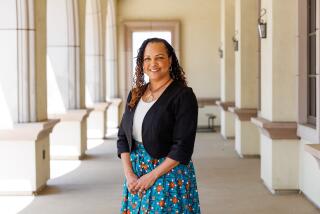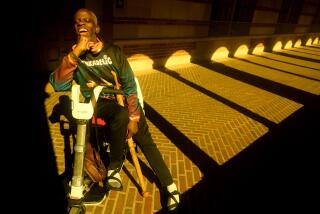Sports Camp Builds Muscles and Self-Esteem : Athletics: Youngsters who use wheelchairs get a lesson in maximizing their physical ability--and having fun--on the SDSU campus.
- Share via
Paul Cody’s years as a high-school athletic star ended suddenly two months ago when he was in a motorcycle accident.
“One day I was walking, and then the next day I’m in the hospital, and they’re telling me I’m never going to walk again,” the 17-year-old said.
For Cody, who had lettered in cross-country running, basketball, baseball and football, using a wheelchair for the rest of his life meant a radical adjustment in doing even the simplest things, such as getting out of a car or moving to another seat, he said.
Cody, who plans to attend a community college this fall, is one of 47 wheelchair-bound youngsters who on Tuesday began a week of sports camp at San Diego State University, getting a taste of what wheelchair athletics is like.
At 6-foot-1, Cody never before had trouble reaching the hoop rim in basketball, he said. But, in his wheelchair, he found it a challenge Tuesday to reach even the considerably lower hoop used in wheelchair basketball.
Despite that, and, even though he has lived only two weeks with his wheelchair, Cody was game as he surveyed the court from a lower perspective.
“It’s a long ways from down here,” he said, laughing and shaking his head.
The fifth-annual San Diego County Junior Wheelchair Sports Camp is geared toward students like Cody, ages 6 to 18, who have had little or no exposure to wheelchair athletics, said Director Marla Knox.
“Instead of just staying at home, feeling sorry for themselves,” Knox said, participants learn tennis, archery, basketball, weightlifting, swimming, and track and field events in the camp, which runs through Saturday. Knox says it is the only camp of its kind in the county.
Like other sports camps, students are coached by athletes--in this case, professional wheelchair athletes--and have four 45-minute workouts every day, Knox said.
The idea is to get the youths interested enough in a sport to continue training on their own, Knox said. The camp, funded by sponsors and volunteers, has gotten more popular each year, and this year’s turnout has been the largest, she said.
“If I can get one or two kids out of this group to continue on, to take the sport a step further, then it’s all worth it,” said Dan Ansley, a 30-year-old counselor from San Diego, who is coaching track and field events at the camp. He also is a five-year member of the U.S. Disabled Ski Team.
Another crucial goal of the camp is to give students self-esteem, Ansley said.
Most people have “a lot of misconceptions” about what a wheelchair-bound person is capable of, said Ansley, who has used a wheelchair for six years since a car accident. “Athletics is a tangible accomplishment,” he added.
Cody knows already about how differently people treat those who use wheelchairs. They avoid eye contact or act embarrassed. Most of the people he called friends deserted him after they found that his new physical disability made them uncomfortable, Cody said.
“They didn’t know how to cope with it.”
He sees things from a different perspective.
“Everyone has a handicap,” he said. “It just depends how well they’re hiding it.”


